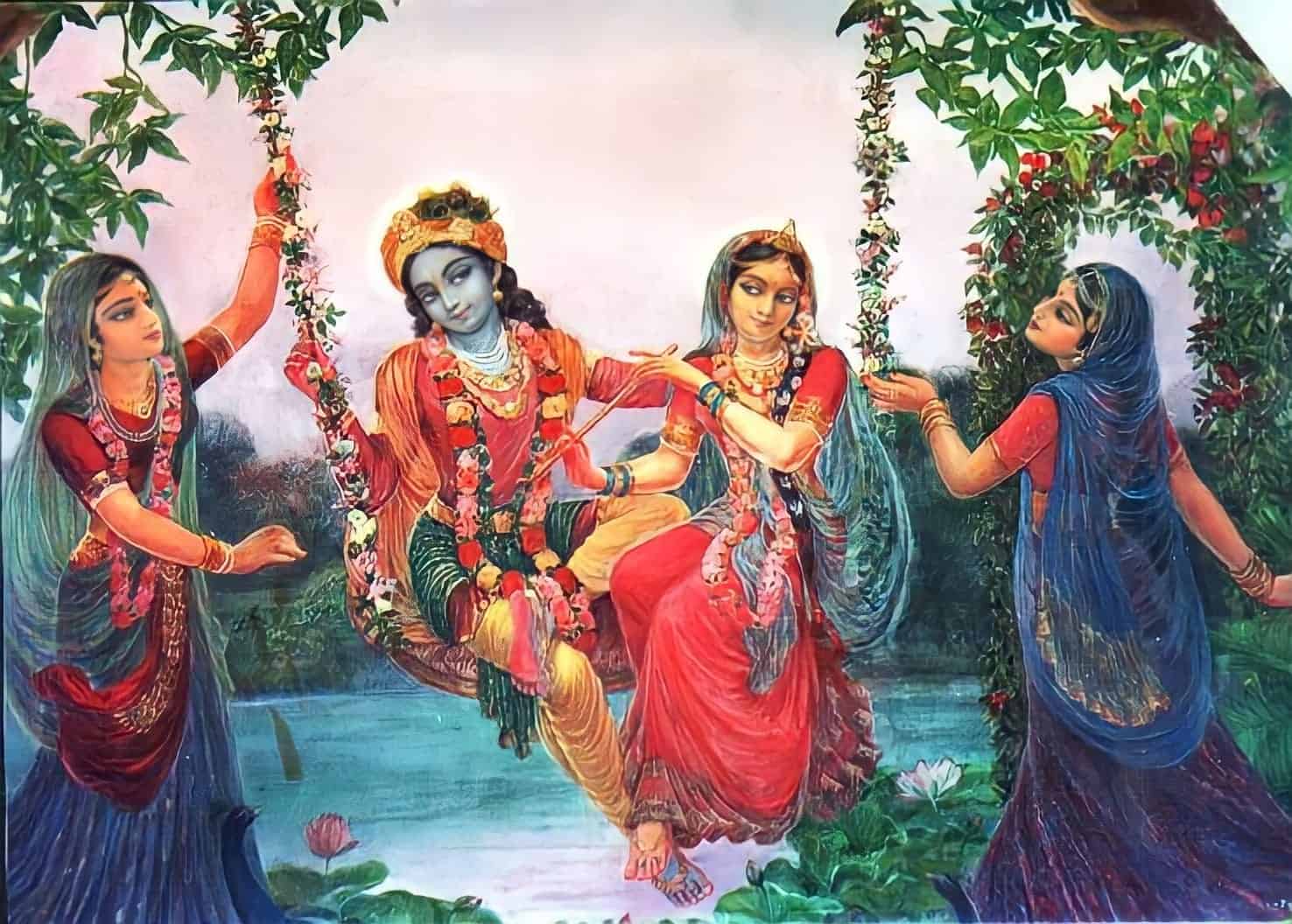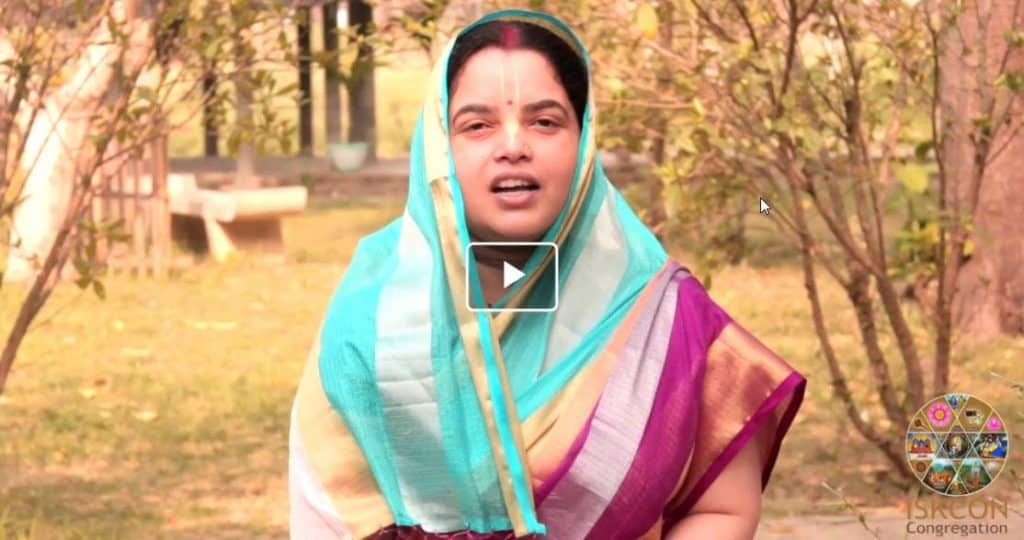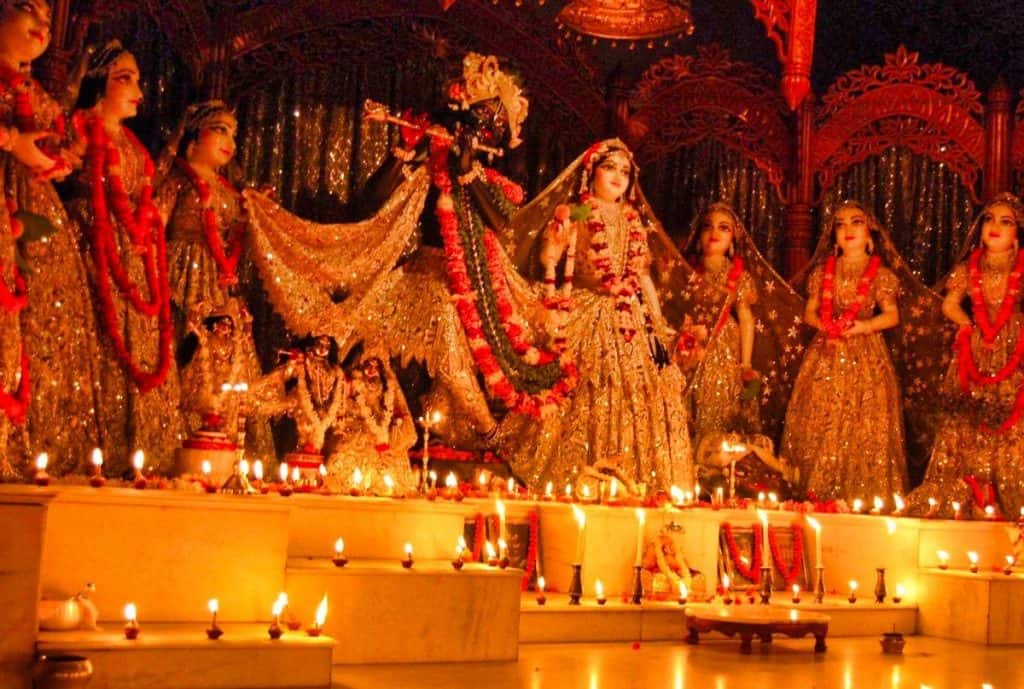One of the most popular events in the holy city of Vrindavan, India, where Lord Krsna appeared 5,000 years ago, is the celebration of Jhulan Yatra, the Radha-Krsnaswing festival. In Vrindavan, between the local villagers and the inhabitants, this festival lasts 13 days. In Vrindavan, this is one of the biggest festivals of the year and Vrindavana is very crowded at the moment, literally hundreds of thousands of people from surrounding towns and villages visit Vrindavan during this period in the auspicious holy month of Shravana (July-August) . Opulence or simplicity, but often the swings are made of gold or silver.
In Shri Vrindavan for five days, in many of the 5000 temples found there, the small functional Deities of Utsav-vighraha (Vijay-utsav bera) are taken from the altar and placed on a tastefully decorated swing in the hall. temple. After receiving traditional arati worship, the Deities are pushed into their swing. Members of the congregation are invited to participate. Each person offers flower petals and personal prayers, and then pushes the swing several times while the other members chant Hare Krsna, Jaya Radhe Jaya Krsnajaya Vrindavan, or Jaya Radhe, Jaya Jaya Madaya, dayita in Kirtan. The atmosphere of this festival is especially sweet, as everyone has the opportunity to intimately serve Radha and Krsna.
The same festival is observed in other parts of India also in this holy month of Shravana. For example, on Jagannath Puri, for the pleasure of Lord Jagannath’s utsav vighraha (Madan-mohan ji, this festival is celebrated from Shravana Shukla Dashami (10thithithi / Moon phase of the light fortnight) to Pratipada (1st tithi of darkness). ), a period of seven days. Shri Madanmohan, the representative deity of Jagannath (vijay utsav), as well as Laxmiand Vishwadhatri are placed on a decorative wooden swing at Muktimandap (Jhulanmandap). There, worshipers have the opportunity to cough up the Lord , thus entering His pastimes.On the day of the full moon (Gamha Purnima or Jhulan Purnima), the day of Lord Balabhadra’s appearance is celebrated.
In Vrindavan it begins on the Tritya (third day) of the bright night of Shravana and lasts until the full moon night of the month. During this festival, the Radha-Krsna Deities in the temples are set in motion. Some of the main temples where this festival is celebrated are the Banke Bihari Temple and the Radha-Raman Temple in Vrindavana, the Dwarkadish Temple in Mathura, and the Larily Lal Temple in Varsana.
In our Iskcon temples we observe for five days according to Srila Prabhupada’s instructions. So whether one observes for the four days or the seven or thirteen days, the same feast is celebrated for the pleasure of the Lord and his loving associates.
This is a wonderful ceremonial function of Lord Krsna’s pastimes that practically reflects how we should render service to the Lord for his pleasure.
At the time of the Jhulan Yatra festival, it is the monsoon in India and the air is dense, heavy and humid with heat and rains. In the middle of the rainy season, when the fields and jungle have turned lush green and flowers are blooming, the Hariyali Teej festival is celebrated.
These festivals are by no means mere rituals, as they all have practical service functionality to invoke the loving servitude of voters to the Lord. Lord Shri Krsna is the supreme enjoyer and he does not have to work hard like we do in this world. Everything He does is enjoyable, and He arranges many situations in which He can incorporate us, the separate parts of him and plots of him into his loving service that is our natural condition in the spiritual realm.
When Shri Krsna had his pastimes in rural Vrindavan with his herding friends together, they lovingly looked after the cows and roamed the pastures playing, having fun and feasting. Throughout the various seasons, everyone continuously enjoyed being a part of Shri Krsna’s pastimes and rendering loving service to the best of their ability.
Over the past few months, the weather had changed from VasantPanchami (spring festival) where everyone dresses in yellow and goes to the fields, performs fertility rites and plants new crops, etc.) to Dola Purnima, where they are thrown powders and scented flowers to the body. of the Lord playfully, and the singing and dancing continues for his pleasure. Similarly, all the other different festivals were observed where Lord Krsna’s friends took care of the comforts or pleasure of His Expressions, went to the forest with Him, served Him and had fun.
As the temperature rises towards the summer, the Chandan Yatra is performed from the Akshaya Tritiya over a period of 21 days, the Lord’s body is anointed with scents of sandalwood mixed with camphor, musk and saffron. As the sandalwood is applied to the body, it cools down immediately, but then there is a natural cycle that, in addition, with the heat, there is naturally some perspiration, and the perspiration mixes again with the sandalwood, it is dries and cools with the slightest breeze, creating a pleasant sensation. Be covered with talcum powder.
However, as the temperature increases to be anointed with something, the cooling is not enough, therefore, in (or from somesampradayas or temples) the Snan Purnima in the month of Jyestha (Meuse of Trivikram Vaishnava) the ceremonial bath of the Lord called Snan Yatra. Although it has become especially festive at Jagannath Puri, the actual event originates from Vrindavana with the devotees bathing Krsna, and Balaram for the pleasure of him and then bathing as well. Actually, at this moment there is no other consolation than bathing in some kind of pleasant water. All Vrindavan temples follow this festival, and many devotees follow a pilgrimage path from temple to temple from early morning until late at night, when the temperature drops to about 35-40 degrees Celsius absorbed by the Snan rasa.
The next important interactive event is Ratha yatra, where the devotee symbolically brings Lord Krsna (Jagannath) his brother Balaram and Subhadra maharani in tall chariots, with beautiful cloth awnings, back to rural Vrindavan after his spell at Kurukshetra.
After this comes the Jhulan Yatra festival. Starting from the ekadasi of the crescent moon of the month of Sridhara, many temples in Vrndavana celebrate Krsna’s swing festival, some for a day, some for days. Traditionally, many of the Lord’s Deities wear various garments with green in this period until Balaram Purnima. Again it is a practical festive service that the devotee provides for the Lord. The monsoon is very humid and the temperature remains very high despite the cold rains. With so much water coming from the sky, on the ground, and just about everywhere, the last thing anyone wants is more water to cool off. The opulence at this time is finding a breeze, as the air is loaded with moisture from the rains. So devotees take care of the pleasure and satisfaction of Krsna, Balaram and Shrimati Radhika by placing them on a swing (Jhulan) and creating their own breeze from them.
It is a very enjoyable and satisfying festival, with swings often heavily decorated with forest vines, Jasmine (Malati) that has recently bloomed in season, and garland streamers. Sometimes they use a fine mist of rose water and direct it towards the Divine couple of Radha and Krsna on their swing.



